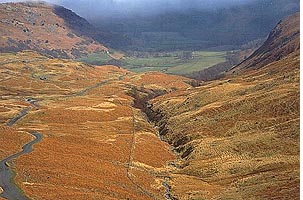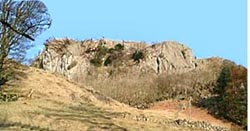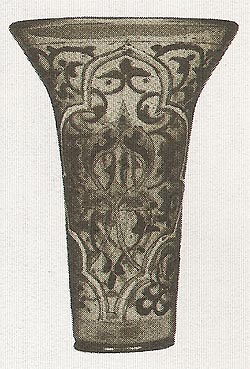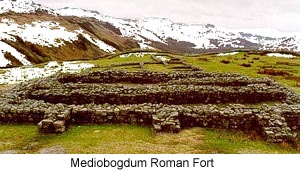The Fairy Hills of Cumbria
by Dr. Gareth Evans
The county of Cumbria -- formed from the amalgamation of the old counties of Cumberland and Westmorland -- lies at the extreme northwest of England. Originally forming part of an ancient Celtic kingdom which extended over what is now the border into modern Scotland, many of the themes of the legends and folklore of the region reveal this origin very clearly. One example is the ubiquitous association, evident throughout the county, with the great Arthurian legend -- though given that Uther Pendragon, Arthur's father, is said to have been king here during the 5th Century, this is somewhat understandable. However, perhaps the most clear example of Celtic influences is the prevalence of fairies -- the "tylwyth teg" (the fair ones) -- in local folklore and few parts of the county are without their own fairy story. Typically these fall into two general types -- tales of hills or barrows where the fairy folk live and stories of the fortune and favour they can sometimes choose to bestow on fortunate humans. In Cumbria, interested visitors can find a variety of sites to satisfy their curiosity, ranging from the supposed court of a fairy king, to a hidden treasure trove and all within easy reach of each other.
King Eveling's Rath
 The Hardknott Pass -- part of the old Roman road from Ravenglass to Ambleside -- is a steep and narrow road with hairpin bends which connects Eskdale with central Lakeland. Overlooking the pass itself, strategically placed above one of the steepest roads in the area, is the old Roman Fort of Mediobogdum, which was built between 120-138 AD. Many of the original features of the site can still be made out, such as the baths and an area of levelled ground believed to have been used for military drills. Despite the clear Roman origins of this remote outpost high in the lonely fells, local tradition holds that a fairy rath stands within the site, where King Eveling holds court. Opinions vary as to the identity and nature of this king. There is some apparent overlap of place associations between him and King Arthur elsewhere in Cumbria, but it has been alternatively suggested that he was a fairy or perhaps elfish ruler, based on the possible derivation of his name from the Old Norse for elf. Whatever the truth, the link between Eveling and Cumbria is a long established one and well documented by William Camden in his book Britannia, published in 1607. The Hardknott Pass -- part of the old Roman road from Ravenglass to Ambleside -- is a steep and narrow road with hairpin bends which connects Eskdale with central Lakeland. Overlooking the pass itself, strategically placed above one of the steepest roads in the area, is the old Roman Fort of Mediobogdum, which was built between 120-138 AD. Many of the original features of the site can still be made out, such as the baths and an area of levelled ground believed to have been used for military drills. Despite the clear Roman origins of this remote outpost high in the lonely fells, local tradition holds that a fairy rath stands within the site, where King Eveling holds court. Opinions vary as to the identity and nature of this king. There is some apparent overlap of place associations between him and King Arthur elsewhere in Cumbria, but it has been alternatively suggested that he was a fairy or perhaps elfish ruler, based on the possible derivation of his name from the Old Norse for elf. Whatever the truth, the link between Eveling and Cumbria is a long established one and well documented by William Camden in his book Britannia, published in 1607.
Bassenthwaite Lake
Some 18 miles north of the Fort at Hardknott Pass lies Bassenthwaite Lake and two reputed fairy sites. The first, a fairy castle or howe, stands just off the main A66, on the banks of the lake itself but the second -- Elva Hill -- is by far the more impressive. The hill itself is locally reputed to be a fairy hill and, according to some, hides a secret gateway into the otherworld, which only opens at certain times of the year. The name, like that of King Eveling, may be of Viking origin, meaning the home of elves, though this is not certain. On the southern slopes of the hill stands a Late Neolithic stone circle, an almost perfect ring some 125ft in diameter, though today comprising around half of the original 30 stones. In reality, the site was almost certainly associated with the trade in stone tools -- produced locally and taken through Borrowdale and over the hills to the east. This may go some way towards explaining the connection with fairies; the Stone Age flints found in the area passed into folklore as "elf arrows" which were supposedly crafted by the fairies -- and subsequently often used by later generations of witches as powerful magical charms.
The Castle Rock of Triermain
 Around eight miles southeast of Bassenthwaite Lake and some three miles north of the towering summit of Helvellyn, the smooth slopes of Great Dodd rise above the surrounding fell. Nearby, close to Watson's Dodd, stands the Castle Rock of Triermain - in fact a craggy outcrop, but a perfectly believable ruin of an ancient castle when seen from a distance - which was named after Sir Walter Scott's 1813 epic Arthurian poem The Bridal of Triermain. According to this account, the crag played host to King Arthur and a group of fairies, while Gyneth, his daughter by the half-fairy Gwendolen was sent into an enchanted sleep by Merlin as punishment for her cruelty, until she was eventually awakened by Sir Roland de Vaux. Around eight miles southeast of Bassenthwaite Lake and some three miles north of the towering summit of Helvellyn, the smooth slopes of Great Dodd rise above the surrounding fell. Nearby, close to Watson's Dodd, stands the Castle Rock of Triermain - in fact a craggy outcrop, but a perfectly believable ruin of an ancient castle when seen from a distance - which was named after Sir Walter Scott's 1813 epic Arthurian poem The Bridal of Triermain. According to this account, the crag played host to King Arthur and a group of fairies, while Gyneth, his daughter by the half-fairy Gwendolen was sent into an enchanted sleep by Merlin as punishment for her cruelty, until she was eventually awakened by Sir Roland de Vaux.
Luck of the Fairies
Although tradition holds that fairies have the power to grant favours, it seems they are seldom disposed to do so too readily and in most stories, hopeful humans have first to successfully undertake some task, or gain some element of surprise. In the case of the fairy steps at Beetham -- a steep series of narrow steps cut into the limestone rock -- the wish of anyone who can climb them without touching either of the sides will be granted.
 While Beetham's steps require something to be done to win fairy favour, the story of The Luck of Eden Hall is an example of how advantage can sometimes be gained if the fairy-folk are taken by surprise. The village of Eden hall lies around four miles north east of Penrith and has been the site of a settlement since pre-Roman times. The Musgrave family lived here from 1500 -1900 and according to legend, their prosperity depends on the fate of an ornate Venetian glass -- widely supposed to be amongst the oldest glasses still in existence in England -- supposedly stolen from the fairies. While Beetham's steps require something to be done to win fairy favour, the story of The Luck of Eden Hall is an example of how advantage can sometimes be gained if the fairy-folk are taken by surprise. The village of Eden hall lies around four miles north east of Penrith and has been the site of a settlement since pre-Roman times. The Musgrave family lived here from 1500 -1900 and according to legend, their prosperity depends on the fate of an ornate Venetian glass -- widely supposed to be amongst the oldest glasses still in existence in England -- supposedly stolen from the fairies.
Sometime during the reign of Henry IV or Edward IV, while heading to fetch water from the estate well, the Musgrave butler came across a group of fairies dancing on the grass. Seeing the glass -- now known as The Luck of Eden Hall -- lying where they had left it, he seized it and reused to give it back to its rightful owners, despite their protests. Angry, but unable to contest the matter further, the fairies were forced to abandon the glass, promising that "Whene'er this cup shall break or fall, then farewell the luck of Eden Hall." Unsurprisingly, successive generations of Musgraves did all they could to ensure the safety of the goblet.
Though Eden Hall was auctioned in 1934 and systematically dismantled, the Luck remained unbroken; it was purchased in 1954 by the Victoria and Albert Museum, where it remains today.
As a final offering from Cumbrian fairy-lore, the treasure of Moresby Hall has more than enough to keep the most ardent erstwhile Indiana Jones or Lara Croft entertained on vacation. An enormous fortune lies buried somewhere around the Hall, awaiting the arrival of someone who can overcome the enchantment and retrieve it. The treasure was hidden away by the fairies, some sources suggesting at the time of the Roman persecution of the Druids. Ever since, on one night of the year, a fairy fountain appears beneath the house and pours out the waters of a magical lake, upon which a single swan swims, singing a dreadful lament on the death of the Moresby line. Only someone who hears this song and has sufficient grasp of Druidic lore to answer the questions asked by the fairies who guard it still, will be able to enter the secret vaults, turn off the fountain and claim the waiting prize.
Many theories have been put forward to explain the continuance of the fairy tradition, but none seems able to provide a truly comprehensive explanation of the enduring myth. One thing, however, is certain. Irrespective of their real origins or nature, shadowy and elusive as ever, fairies do seem to have a unique ability to survive -- and nowhere perhaps more understandably than on Cumbria's wild and lonely fells.
Locations

King Eveling's Rath/Mediobogdum Fort: The fort lies on the north side of Hardknott Pass, towards Eskdale, in the heart of the Lake District National Park. The minor road through the pass connects Ambleside near Windermere, with Ravenglass on the coast.
Bassenthwaite Lake: About 4 miles east of the town of Cockermouth, beside the main A66. Elva Hill stands above a minor road to the north east; the stone circle is on its southern slopes on private land, but access can be made over the public footpath leading from the road.
The Castle Rock of Triermain: Close to Great Dodd, beneath the summit of the nearby Watson's Dodd, around 3 miles due north of Helvellyn. The site is easily accessible from either A66 (which passes to the north) or the A591 (passing to the west).
The Fairy Steps: Beetham lies off the A6, about 6 miles north of junction 35/35a of the M6, just north of the Lancashire/Cumbria border. Access to the steps is from a footpath through woodland, to the west of the church.
Edenhall: The village lies 4 miles north east of Penrith. Although Eden Hall is no more, there are other sites worth visiting -- St Cuthbert's Church is about half a mile from the centre of the village and nearby is a stone cross on top of a plaque stone, dating from the time of the Black Death (1347-1361).
Moresby Hall: The Hall, which is now a private guest house, is 1.5 miles from Whitehaven off the A595. There has been a settlement at Moresby itself since at least Roman times.
Related Articles:
- Castlerigg, Long Meg and Her Daughters, by Lisa Agnew
- https://www.timetravel-britain.com/articles/stones/meg.shtml
- The Stone Circles of Cumbria, by Dr. Gareth Evans
- https://www.timetravel-britain.com/articles/stones/stones.shtml
More Information:
We regret that we no longer have the resources to maintain up-to-date links and/or hours and pricing details for the various sites and attractions listed on this website. For more information about the location(s) listed above, please use your favorite search engine or visit Wikipedia.
Gareth Evans is a freelance writer and photographer, having previously worked in the private sector before lecturing at the University of Durham. Having travelled extensively, he now concentrates on writing about subjects much closer to home -- both geographically and metaphorically. He is particularly interested in myths, legends and folklore, together with the often forgotten history of the Celtic lands, especially that of his own native Wales and Scotland, his adopted home. Gareth is currently planning his next book, looking at the role of the pagan Horned God in myth and history.
Article and photos © 2005 Gareth Evans
|
